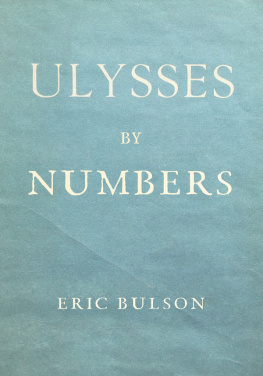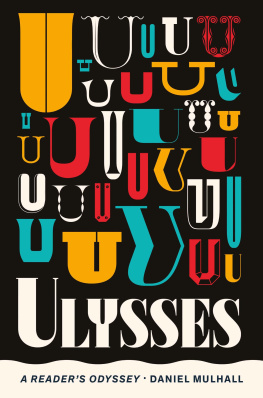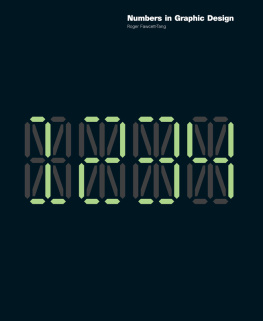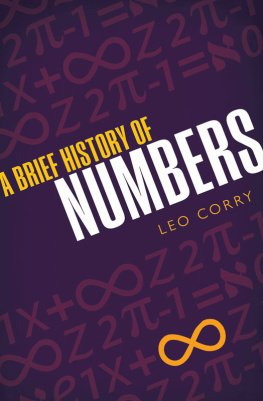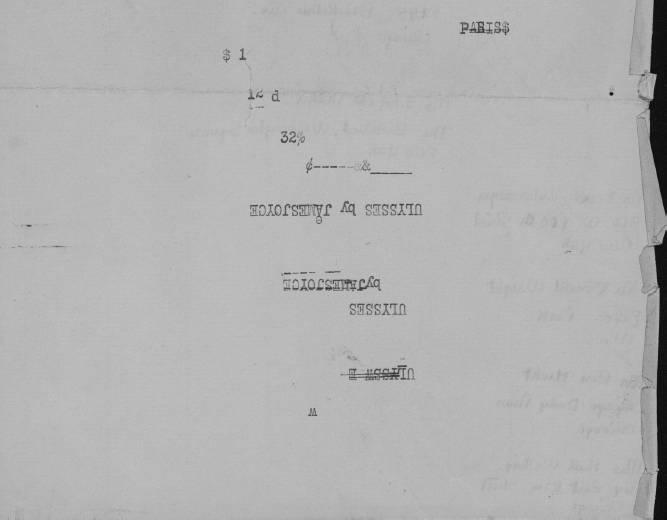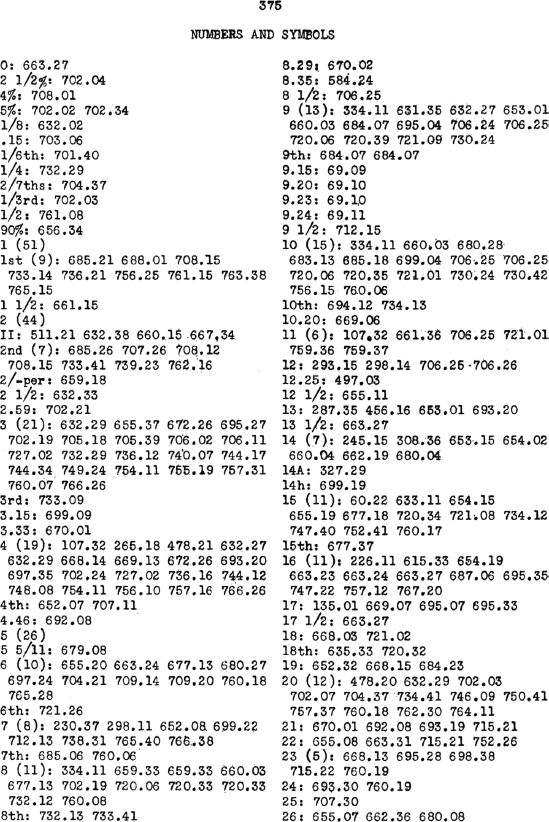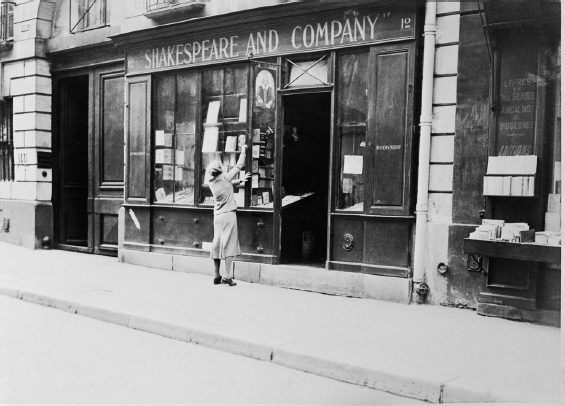Table of Contents
Ulysses
by Numbers
Ulysses
by Numbers
Eric Bulson
Columbia University Press
New York
Columbia University Press
Publishers Since 1893
New York Chichester, West Sussex
cup.columbia.edu
Copyright 2020 Columbia University Press
All rights reserved
E-ISBN 978-0-231-54647-8
Library of Congress Cataloging-in-Publication Data
Names: Bulson, Eric, author.
Title: Ulysses by numbers / Eric Bulson.
Description: New York City: Columbia University Press, 2020. | Includes bibliographical references and index.
Identifiers: LCCN 2020015071 (print) | LCCN 2020015072 (ebook) | ISBN 9780231186049 (cloth) | ISBN 9780231186056 (trade paperback) | ISBN 9780231546478 (ebook)
Subjects: LCSH: Joyce, James, 18821941. Ulysses. | Joyce, James, 18821941Literary styleData processing. | Symbolism of numbers in literature. | Criticism, TextualData processing. | LiteratureResearchMethodology.
Classification: LCC PR6019.O9 U63215 2020 (print) | LCC PR6019.O9 (ebook) | DDC 823/.912dc23
LC record available at https://lccn.loc.gov/2020015071
LC ebook record available at https://lccn.loc.gov/2020015072
A Columbia University Press E-book.
CUP would be pleased to hear about your reading experience with this e-book at .
Cover design: Chang Jae Lee
For Kent Puckett
1 in 1,000,000
Source: Courtesy of the British Library.
Contents
Illustrations
PARATEXT
INTRODUCTION
No 1
No 2
No 3
No 4
No 5
I never imagined that I would write a book about numbers and definitely not one involving Ulysses. But it all happened largely because I was never left alone for too long with my ideas. From the start, Ive been fortunate enough to have so many others offer support. Friends have been there, of course, but also colleagues, students, and acquaintances. Without all their questions, comments, corrections, and bouts of disbelief, Im afraid the words that follow would never have counted for much.
Foremost among them, Philip Leventhal, not only for the encouragement to bring this all together as a book, but also for the direction necessary to help me gauge the scope and scale along the way. And then there are all the readers who provided critical assessments just as the counting got underway: Jean Day, David Weiss, Ian Gunn, Erik Schneider, Jean-Michel Rabat, Hoyt Long, Richard So, Jim English, David Kurnick, and Jim Shapiro. As the counting continued, I could also depend on Edi Giunta, Kevin Dettmar, Franco Moretti, Michael Groden, Andreas Huyssen, Hans Walter Gabler, Evan Kindley, Aaron Matz, Josh Kotin, and David Kastan. For quick answers to the nitty-gritty genetic questions, I was fortunate to have Ronan Crowley to rely on. With all things related to copyright, there was Bob Spoo, a benevolent legal force in the scholarly community.
But a book like this doesnt get written without relying on the technical know-how of others. Among them, Nicholas Rougeux, a web designer and self-proclaimed data geek, who has a gift for making numbers beautiful. And then there is Warren Roberts, GIS-guru, who volunteered so much time to get these maps plotted and properly oriented. But none of this, of course, would have been possible without the data. For that I am indebted to Alyssa Krueger, my indefatigable research assistant, who collected and cleaned the numbers more times than either of us can really remember. The data collection was never straightforward and required not just remarkable patience but also a real understanding of the larger questions that were being asked.
Over the years, I received generous funding from the Digital Humanities Center at the Claremont Colleges and my own department of English at Claremont Graduate University. I owe a particular debt of gratitude to Ashley Sanders-Garcia, Dan Michon, Leigh Leiberman, and Aaron Hodges. Thanks are due as well to the National Endowment for the Humanities for a fellowship that gave me the luxury to write and research relatively uninterrupted for an entire year.
From the beginning to end of it all, there was Kent Puckett, a dear friend I could always count on to read drafts, ask tough questions, refine a phrase, and direct me to an unexpected source. This book is better because of him, but he also made it a lot of fun to write in the meantime. And, finally, I owe everything else to Finn, Leif, and Mika: the three people who keep reminding me that love doesnt have a number.
Source: Courtesy of the Manuscripts Division, Department of Special Collections, Princeton University.
Source: Courtesy of Getty Images.
J ust opening a copy of Ulysses, you may have already missed the first number. And theres a good reason: it is not one you can actually see. Instead its the sum you get when counting the letters of the title on the cover:
U + L + Y + S + S + E + S = 7
Another set of numbers (escaping Kenners notice) awaits us on the title page, this time identifying the address of Shakespeare & Company (12, rue de lOdon, 12) and the year of publication (1922). Though it looks like a conventional publishers noteone that received the bon tirer, ready to print, from Joyce during the proof stagethe two 12s surrounding the rue where Ulysses was getting wrapped for distribution just dont add up. The first identifies the building number of Sylvia Beachs bookstore, but the second gets the arrondissement and the numerical formatting wrong (VIe). Or does it? A pair of 12s could be found painted on the outside of Beachs bookstore, as was customary in Paris at the time (). But we also cant forget the date when the novel itself arrived in the world.
The entire printing house is pleased to offer you the first copy on the date of 2 February [[Lofficine toute entire] est heureuse de vous offrir le premier exemplaire la date du 2 Fvrier], Maurice Darantire, the owner, wrote to Sylvia Beach, the publisher.
Twenty-two, it turns out, is also the age of Stephen Dedalus when Ulysses opens, the number of books in the Old Testament (according to Flavius Josephus) and the letters in the Hebrew alphabet, and it was also the original number of episodes (before Joyce settled on 18), the number of hours in Ulysses, and the letters in the Irish alphabet. If you keep counting, you will discover that 22 is the number of words printed en francais on the copyright page. It is the same number, in fact, that Kenner counts in the opening sentence of the novel, one mirroring the sum of syllables that can be found in 2 lines of hexameter, the meter of Homers

